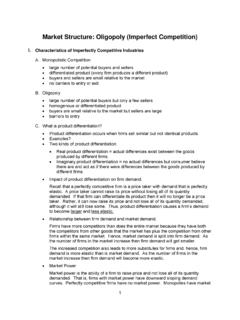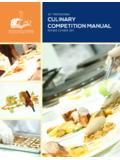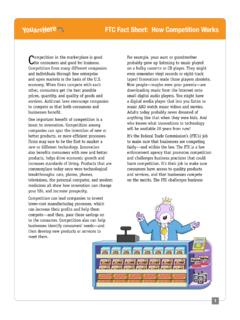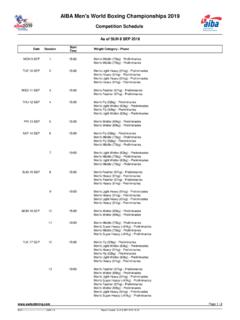Transcription of American Society of Mechanical Engineers Student Design ...
1 American Society of Mechanical Engineers Student Design competition Building to the Sky 2020 Contest Design Problem Description Manufacturing activities employ a significant percentage of Engineers , they account for a large share of private research and development spending, and will continue to play an essential role in innovating our future. Necessary advances in technology will require both skilled Engineers and novel manufacturing techniques. This year's challenge requires teams to build a compact engineering system capable of manufacturing a tower made exclusively from standard-sized sheets of paper detailed in the rules below.
2 The validation of your Design will include testing for manufacturing speed, height of tower, and ability to support a load. The testing will occur at each of the ASME EFest Student Design Competitions taking place in 2020 teams may only participate at one EFest. Preliminary Rules: team eligibility, Design constraints and general evaluation procedures: 1. Students participating in the competition must be undergraduate engineering students (any engineering discipline is allowed) and must be ASME Student members. There is no limit on the number of students on a team or the number of teams from a school.
3 Each Student may only participate on one team (contribute to one device) participants from schools fielding more than one team will be asked to affirm this at the competition . 2. Teams must provide a rigid sizing box with a top for the device and tools the team would use to make minor repairs during the competition . This box must be less than 50. cm x 50 cm x 50 cm (internal dimensions). Throughout the competition , the device and any tools, as well as all extra batteries, must fit completely and remain stored within the sizing box. Do not show up at the competition without a legal sizing box and tools!
4 3. The competition will take place over two days. Design modifications are allowed between Day 1 and Day 2, but devices must remain unaltered and within the sizing box between all rounds on each day. 4. To begin each round, devices will be taken from the sizing box and placed into a testing area marked by tape on the testing area floor. Devices must remain in contact with the floor at all times. Devices may only rest on the floor, and may not be secured to the floor. 5. All energy for the device must be provided by rechargeable batteries. Other forms of stored energy, such as pre-compressed springs or compressed gas, are not allowed.
5 6. Teams may replace batteries between any rounds, however replacement batteries must be rechargeable, and be stored in the sizing box throughout the competition . Test Setup Rules: preparing for testing, operator/device operation 7. The testing area dimensions will be 2 meters x 2 meters, with boundaries marked by the inside edges of tape on the floor. Team devices will be brought to the testing area in the team sizing box. 8. Teams will have 1 minute to remove the device from the sizing box and prepare the device to perform each round of testing.
6 Other than connecting power to the device and setting up to operate, no modifications are permitted during this setup time. 9. The testing area surface will be reasonably level and may be either smooth or non-smooth ( hard surfaces, carpet, or other flooring typically found in public areas). 10. Devices must manufacture a single, self-supporting tower from multiple sheets of 20-lb, A4 or 8 x 11 inch standard Letter-size paper. The paper must not be modified before manual loading, and the device may only fold, cut or mechanically join individual sheets of paper -- no additional materials (solid or liquid) may be added to the sheet of paper before or after it has been loaded into your device.
7 11. Teams are responsible for supplying all of the own paper, and may be asked by the judges to verify that the paper has not been modified. Paper does not have to fit in, or be stored in the team sizing box during the competition . 12. The paper tower may remain in contact with the device throughout each testing round. 13. No device component may exceed a 50 cm height from the floor at any time during testing. Only the paper tower will rise above this height limit. 14. Teams may not use more than 100 sheets of paper in any round of testing. 15. Only one team member will be allowed to manually load the paper, one sheet at a time, so that the device can connect it to the prior sheets of paper.
8 Your device should have a control panel(s) to activate all connecting operations, which may be operated manually by a second team member, or by the paper loader. 16. The person loading paper may hold the sheet while the device is gaining control of the sheet, but must release the paper before it has been connected to prior sheets. Manually controlling a sheet as it is being fabricated into the tower will immediately end the round. 17. Teams are allowed more than one paper feeding system and location on their device, but paper feeding must be done one sheet at a time, by the designated paper loader.
9 Teams are allowed more than one control switch, located anywhere on the device. 18. With the exception of loading each sheet of paper, interfering with the operation of the system after the sheet has been loaded, or touching the paper tower at any time during the testing will immediately end the round. 19. Each device testing run will last until a team member signals to the judges that they do not wish to add any more paper, or until the given event time has been reached. Qualifying Testing Rules: initial rounds of performance measurement 20. During the first day of the competition , devices will be tested in each of the following three modes of operation Higher.
10 Build the tallest paper tower possible within 10 minutes. Faster. Build a m tower as quickly as possible. (5 minutes maximum). Stronger. Build the strongest paper tower possible within 10 minutes 21. Multiple teams will operate their devices at the same time this will expedite the competition . The number of simultaneously operating devices will be determined by the lead judge(s) at each EFest. 22. For the Higher testing rounds, all teams will be scored by their final tower height. Teams may stop building at any time they wish, but must stop at 10 minutes.




